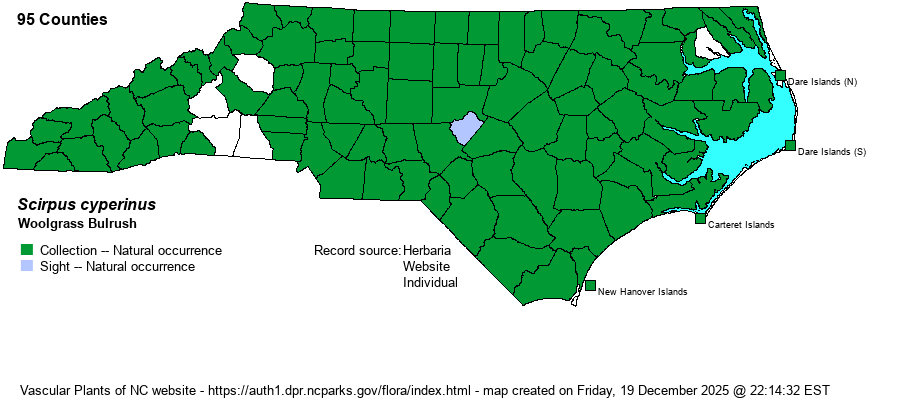| Author | (L.) Kunth | |
| Distribution | Throughout the state. One of our commonest sedges and no doubt found in every county.
Newf. to B.C., south to FL, TX, and OR. | |
| Abundance | Common throughout; plants are sometimes abundant in large marsh systems. | |
| Habitat | Freshwater and fresh-tidal marshes, beaver ponds, impoundments, river shores, swamp openings, interdune swales, wet powerlines, damp roadsides, ditches, and wet clearings -- typically in open wetlands. |
| Phenology | Flowering and fruiting July-October. | |
| Identification | This very familiar species is readily identified by its rusty or cinnamon-colored spikelets, arching and drooping inflorescence branches, and long "woolly" seed bristles. The stems grow 3-6 feet tall from long, scabrous, basal leaves which often have a tussock-like appearance. In general, the species has a thicker or "bushier" inflorescence, composed of simply uncountable spikelets, than practically any other graminoid. | |
| Taxonomic Comments | Varieties eriophorum and rubricosus need additional study to determine if they should be recognized.
Note that the genus Schoenoplectus has been split from Scirpus and includes plants with sessile spikelets, or with spikelets with a few branches (vs. open, widely branching inflorescences). Most of our Schoenoplectus species appear to have no leaves (exceptions are S. etuberculatus and S. subterminalis), whereas Scirpus taxa have well-developed basal and stem leaves. | |
| Other Common Name(s) | Often called simply as Woolgrass, but as it is not a grass, the editors and a few other references prefer the less misleading Woolgrass Bulrush. Woolly Bulrush, Common Woolsedge | |
| State Rank | S5 | |
| Global Rank | G5 | |
| State Status | | |
| US Status | | |
| USACE-agcp | OBL link |
| USACE-emp | FACW link |

